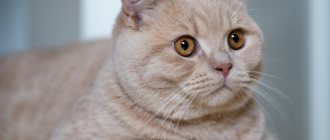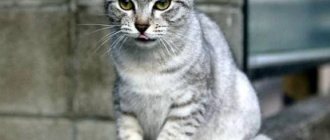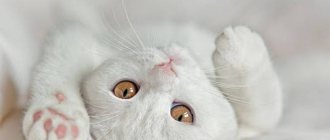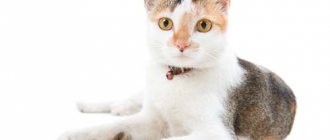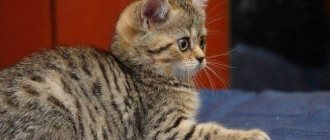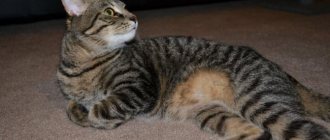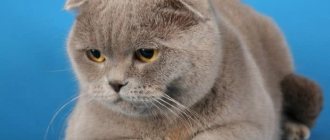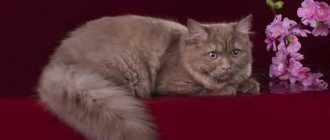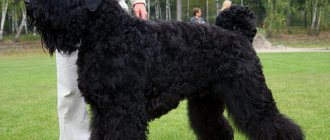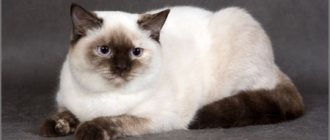The British Shorthair is a purebred version of the traditional English cat, with a characteristic stocky body, densely padded coat and broad muzzle.
The most familiar color variant of British cats for the average person is blue or blue; this is a solid blue-gray coat, copper eyes and a medium-sized tail.
Few people know that this breed has also been developed in a wide range of other colors and patterns, including tabby and various color morphs.
Types of colors
The colors of British cats are a variety of colors. The most popular are blue and smoky pets. True, few people know that parents who have a certain color can produce different offspring at different times. How to do this is the task of the breeders.
All types of colors are usually divided into groups, which lead to the fact that cats are distinguished by:
- color dominance;
- drawings;
- pigmentation.
Next we will talk about popular and rare species, as well as their external distinctive features based on color.
Plain and smoky
The monochromatic color of a British cat implies the presence of exclusively one color without any inclusions. That is, the animal’s fur, undercoat, and skin should have only one tone. If an animal has slightly visible spots or stripes, it will no longer be classified as that variety.
Important! Solid-colored kittens after birth may have various dark spots, this is the norm. After a year, these spots go away.
Popular solid British cats are:
- white (it is believed that they were one of the very first to appear in the world);
- red;
- lilac;
- blue;
- chocolate;
- black;
- creamy.
Despite the fact that black cats are popular, in recent years the animals have been extremely rare. Breeders note that it is difficult to obtain such a shade.
Smokey Brits are not uncommon. Often these are the pets that live in many people’s homes. This shade is not difficult to obtain, so cats of the presented colors have gained wide popularity and love. In addition, the cost of animals with such fur is low, which gives everyone the opportunity to buy a four-legged friend for themselves.
A little history of the breed
They are one of the oldest known breeds, descended from European domestic cats imported to England at the same time as the Roman invasion in the first century AD. Today it remains the most popular breed in its native country, as registered by the UK Governing Council for Cat Fancy (GCCF).
The origins of the British Shorthair most likely date back to the first century AD, making it one of the oldest identifiable breeds in the world.
It is believed that the Roman invasion originally brought Egyptian domestic cats to Britain. These animals were then interbred with the local European wild cat population. Over the centuries, their natural isolated descendants evolved into very large, robust beasts with short but very dense hair, to better withstand the rather harsh climatic conditions of their home islands. Based on artists' views, the modern British Shorthair is no different from this original type.
On the left you see blue colors. On the right are the tabby, red, cream and cinnamon varieties in the first photo, tortoiseshell in the second and bicolor in the third.
Selective breeding of the best specimens of this breed began in the nineteenth century, with an emphasis on developing an unusual blue-gray variant called the "British Blue" or "English type" (to distinguish it from the finer-grained "Russian").
Some sources directly credit British artist and cat lover Harrison Weir with the original concept for standardizing the breed. Others suggest that a group of breeders was involved in the selection.
The new British Shorthair was introduced at the first ever cat show, organized by Weir at the Crystal Palace in London in 1871, and enjoyed great initial popularity.
British golden chinchilla
By the way, you can read the article about the British golden cat.
By the 1890s, with the advent of newly imported Persians and other longhair breeds, the British Shorthair was no longer as widely popular, and its breeding stock became critically rare during the First World War.
At least partly to save the breed, breeders mixed Persians with their bloodlines. The genes introduced in this way would eventually become the basis of the British Longhair. At that time, any longhaired cats produced were included in the Persian breeding program, as all blue cats were then rated together as non-de facto single breed options. Blue Shorthairs, the result of crossing the early British with Russian Blues, were also common.
Blue color
After the war, in an attempt to maintain the breed standard, the GCCF decided to accept only third generation Perso-British Shorthair crosses for registration. This also contributed to the destruction of the pure breeding stock by the beginning of World War II, after which the Persian and Russian Blue were reintroduced to the list of acceptable crosses.
Blue kitten
In addition, felinologists have also worked with the French Chartreuse, another ancient breed that, although not genetically related to the British Blue, is very similar visually. Breeders devoted much attention to restoring the true English type, and by the late 1970s the British Shorthair had received official recognition from both the Cat Fanciers' Association (CFA) and the International Cat Association (TICA).
Blue color
It is again the most popular cat breed in the UK, according to the GCCF 2013 registry.
White
White beauties are incredibly gentle and soft. The skin has a light pink color. Often these are British people with blue eyes, but in some you can see aquamarine and even multi-colored. The animals' fur is so snow-white that it resembles ice shimmering in the sun or freshly fallen snow. The color can easily be classified as cold. Some people confuse this shade with yellowish, believing that this is the norm, but this is not the case. In the case when white turns into some other color or resembles more flesh-colored, it is no longer classified as this color.
Black
Charcoal-colored pets are incredibly beautiful. The black shimmers mesmerizingly in the light, giving the fur coat some incredible and inimitable shade. Black Britons have been rare in recent years. This is due to a sharp change in shade at six months to one year of age. Babies that are born may be “tar”, but over time the color changes to chocolate or brown. It turns out that initially the breeders believe that they managed to acquire “little devils,” but later it turns out that these are completely different beauties.
Some black cats have chocolate or dark (close to black) undercoat in some places. It is unacceptable. Such pets look very beautiful and unusual, but the animals are already classified as two-colored and cannot in any way be called charcoal.
When buying a black cat, you need to be prepared for the fact that in the future the shade of its fur will change and your furry friend will have a different fur coat.
Visit to the veterinarian
When purchasing a pet, you should carefully read the reviews of visitors to nearby veterinary clinics and choose the right one.
The first vaccination for a kitten is given at 12 weeks.
If British breed kittens are cared for correctly, visits to the veterinarian will not be frequent, but kittens should be seen regularly for examinations and vaccinations during the first year of life.
- Vaccination schedule.
Until a kitten that feeds on its mother's milk is 12 weeks old, there is no point in getting vaccinations, because... With milk he receives antibodies that enhance immunity.
When the kitten is one year old, he is vaccinated against rabies.
At 12 weeks, the baby receives the first comprehensive vaccination, which includes components against rhinotracheitis, calcivirosis, and panleukopenia. The vaccine is fixed exactly after 21 days with a similar composition. When the kitten is one year old, he is given the same vaccination for the third time, and a rabies vaccination is added to it.
Important! It is not recommended to get vaccinated while changing teeth, i.e. at 4-8 months.
Caring for British kittens includes preventive removal of worms.
In the future, the pet is given a comprehensive vaccination and vaccination against rabies every year. Even if the cat is constantly in the apartment, annual vaccination should not be neglected.
- Deworming.
Caring for British kittens includes preventive deworming.
Deworming is mandatory before vaccinations. The procedure must be carried out 10 days before vaccination; the drug can be in the form of a tablet or suspension.
If lice, fleas, scabies mites or lice mites are found on a kitten, it is necessary to treat it with drugs against ectoparasites
Until the kitten is six months old, deworming is carried out monthly.
Once the pet reaches one year of age, worming is carried out once a year.
- Treatment against ectoparasites.
If lice, fleas, scabies mites or lice mites are found on a kitten, it is necessary to treat it with drugs against ectoparasites. The products are available in the form of sprays, powders, drops on the withers - the veterinarian will select the most effective one, because For kittens under 3 months of age, only short-acting medications can be used.
For kittens younger than 3 months, only short-acting medications can be used.
Chocolate
You might think that most black cats turn chocolate over time, but this is not true. Babies, whom nature has endowed with such a shade, have a deep tone in childhood, but not very saturated. The beautiful chocolate shade makes itself felt in six months. The color is so monotonous that sometimes it is impossible to describe it in words. Breeders say that the cost is affected by the depth of color. In some countries, chocolate Britons are also called chestnut or havanna.
Blue
Many people like British blue cats. At the same time, some confuse blue with a silver tint, which is sometimes present. In purebred animals, lightening of the undercoat hairs is allowed, but only by one tone. As for the fur coat itself, there should not be even a hint of any inclusions or discrepancies from the overall color.
People call blue Britons smoky or gray, although, of course, this is not an entirely correct definition. Almost all babies have stains of other shades on their fur coats, which gradually disappear over time. Those pets whose blue color is close to gray are considered elite. This is an incredibly beautiful shade and is rare.
Some unscrupulous sellers claim that blue British cats must have orange eyes. In fact, the majority of handsome people are born blue-eyed, and only over time the eye color acquires a shade that remains for life. And it's not always orange. In some representatives, one eye may be one way, and the other completely different. Therefore, you need to judge solely by the saturation of the wool.
Lilac
Lilac representatives are sometimes also represented as cream British. This is due to the color, which combines soft pink and blue. Words cannot describe the shade because it can vary and be different from one litter to another. Babies, immediately after birth, resemble pink piglets, their fur is so bright. As pets grow older, their fur coat becomes blue.
At the same time, animals owe their additional beauty to their undercoat, which is usually a tone and a half lighter than the main color. The eyes of representatives of this breed can only be amber or copper. If this is not the case, then it will not be possible to classify the animal as a lilac species. Many people want to have such pets, but the presented tone is very rare. Getting it is luck. Breeders have been struggling with this for years and in the end nothing works out.
Faun
Some people believe that the fawn is a cream-colored British cat, but this is incorrect. Newborns resemble small fawns with a light pink-cream shade of fur. Such representatives are extremely rare, which directly affects their very high cost. Experienced breeders recommend that when purchasing such cats, if you still manage to find them, you must ask for exactly this color and no other color to be included in the passport. The reason is that the presented shade can be determined solely by DNA analysis. If the seller refuses to enter the color into the passport, it means that they are trying to sell the wrong animal under the guise of an elite and expensive animal.
Shaded gold and silver color
Many chocolate, black and purple animals have a silver tint. This covers the pet's paws, belly, collar and chest.
As for the golden color or copper color, as breeders also say, it is rare. In this case, the coat is darker at the base, and at the end the hairs appear golden. It is impossible to confuse such pets with others, if only because they have a black tip of their tail, paw pads, and also eyeliner around their eyes. People call this type of cat the domestic chinchilla or the ticked British cat. This color of a British cat is not very rare, because breeders know well how to get it.
When to adopt a kitten
Only a mother cat can provide proper care for newborn British kittens; this is possible in a nursery where kittens are not separated from their mother until they reach the age of 12 weeks. This approach allows:
- gain the kitten the required body weight - 1.5-1.7 kg by 3 months;
- receive complementary foods in the required amount and with the required regularity;
- receive breast milk as the main diet;
- learn self-care skills from your mother;
- undergo vaccination and anthelmintic treatment.
British kittens should be fed 4 times a day with natural food.
Up to three months, there is a high probability of injury for kittens due to weakness of the skeletal system, and complications after vaccinations are also possible. Therefore, reputable nurseries give away kittens that have reached the age of three months.
If the babies are over 2 months old, caring for British kittens is not difficult, although it requires free time. After all, pets should be fed 4 times a day with natural food, preparing fresh meals daily, including the necessary set of vitamins, proteins, fats, carbohydrates, minerals, and acids. A complete switch to dry food at this age is fraught with complications of the digestive system for the kitten. The kitten's weight should double in a month. At three months of age, the kitten is transferred to two meals a day.
It is advisable to give away British kittens at three months of age.
Tabby
The British tabby is some kind of color mix, since the animals can have a golden or silver background, and can resemble a color point shade. On the body of adult animals there are often bright stripes or spots, like a leopard. Babies are brindle or spotted. This is not a deviation from the norm.
Spotted Britons are usually confused with other breeds, but they are distinguished by their eye color, as well as the shape of their ears and habits. In addition, the British have the most dense wool that representatives of the presented breed can boast of.
Tortoiseshell
Tortoiseshell cats must have cream, black and red spots on their faces. Many people believe that a British tortoiseshell kitten is a tabby when it is a baby, but this is not the case. Any patterns indicate a crossbreed. Our four-legged friends have orange or copper eyes.
Tortoiseshell cats usually have color combinations such as:
- Red and cream.
- Brown, black and chocolate (this is already a tricolor cat, but it still belongs to these representatives).
- Blue and purple.
“Turtles” are much more feminine. Moreover, breeders note that only females should have this shade. If a tortoiseshell cat is born, then this is, firstly, a genetic error, and secondly, the animal is almost always infertile. For this reason, many give up the desire to get a similar color of animals, because it is labor-intensive work, and it does not always end successfully.
It is better to get a red British cat or a peach one, but be confident in them than to take risks.
Types of drawings
Tabby is not one specific pattern, as many people believe. There are several varieties of it, and all are considered standard. The pattern appears due to the A gene (agutti). A British female with the color formula “AA” gives birth to only patterned kittens, and with “Aa” the ratio of patterned kittens to plain ones is 50%. Cats with the formula “aa” will be monochromatic.
There are four main types of tabby patterns: ticked, striped, marbled, spotted.
Ticked (Abyssinian)
At first glance, it may seem that the British ticked coat is a solid color, but this is not the case. The color of their coat is not at all uniform: the whole body has barely noticeable stripes, spots or specks (there are “freckles”), slightly darker than the main tone of the British. The tip of the tail is usually dark. Eyes are golden or green.
Striped, brindle (mackerel)
The British tabby cat is the most popular cat available. The second name appeared due to the similarity with the color of the mackerel fish. The pattern is characterized by frequent narrow, clear stripes throughout the body, especially along the ridge. British tabbys are characterized by necklace-like lines on the chest and a broken stripe on the forehead, reminiscent of the Russian letter “M”. The British cat's full brindle coloration develops by the age of one year.
Classic (marble)
One of the most favorite colors among breeders of this breed is the marbled tabby. It is visible already from the birth of the kitten, it may merge slightly, but by two months it has a clear pattern. The body is covered with wide ornate patterns with clear outlines on the back, sides and vague ones on the abdomen and paws. The color of the pattern contrasts with the main shade of the Briton’s body – a kind of marble on silver.
Spotted (leopard)
A cat of the British breed with this coloring is similar to a representative of the wild - a leopard, but in miniature. Wide stripes are intermittent and represent spots of various sizes. Eye color: copper, green.
Marbled or wild
Marble color is a silver or white coat with dark stripes on top. Often the drawings are large in size. Very often, representatives of this color are called “snow leopards.” Some animals have stripes so uneven and large that it looks like the cat is two-colored. In recent years, not only light-colored cats have become marbled. The main tone can be chocolate, black, blue. On the “golden chinchilla” you can even find similar spots.
Annual kitten care calendar
| Deadlines | event title |
| Once a year |
|
| Twice a year |
|
| 1 time every 2 weeks |
|
| 1 time per week |
|
| Twice a day |
|
Wang
Animals belonging to a breed with this color have several subspecies, according to which they differ:
- We are talking about van - the main color is white.
- Bicolor - an animal with large white spots on its fur.
- Miteda - representatives with white paws, as well as a light-colored stripe from the chin to the groin.
- Tricolor is a tortoiseshell color with three shades, which necessarily includes white.
- Harlequin - a large white spot on the fur.
That is, when talking about van, they mean different types of shades that are included in the general group. At the same time, the main color is always white.
Important! Kittens with the meted color are not officially allowed to be bred. This color will not be included in the van group and will not be listed in the passport.
The situation with the shade is very problematic, because it exists, everyone knows about it, but it has not yet been officially recognized. Although such animals look beautiful and unusual.
The first days of a kitten in the house
The long-awaited kitten has been brought. He is scared, cut off from his mother and familiar smells, and does not orient himself in an unfamiliar space. Usually the owner of the nursery gives detailed instructions on the care and maintenance of a British kitten.
Kittens are usually toilet trained at 2-3 months
To make getting used to your new home quick and painless, it is better to act as follows:
- There is no need to grab the kitten, squeeze it and try to immediately teach it to run after a toy - it will struggle, scratch and will perceive its future owners negatively. Therefore, it is better for new owners, especially children, to simply be in the pet’s field of vision, talking to it affectionately and calling it by name. The kitten must be given time to get used to it without scaring it. Soon he himself will come to the owner.
- If the apartment is large, and bowls of food and water and the toilet are located far from each other, then at first they can be placed nearby, but not next to each other. The kitten can be confined to one room for a couple of days, where everything it needs will be located. Then gradually expand the territory, opening doors to other rooms so that he does not get lost and gradually masters the entire apartment.
- In the first days, the animal must be fed with the same food as it was fed in the nursery. The change of food occurs gradually; for this, a new type of food must be gradually mixed into the usual one.
- Kittens are usually toilet trained at 2-3 months. The baby should be shown where his new toilet is by placing a napkin with the smell of his urine there.
The kitten must be given time to get used to its new home.
Having bought a cat, the owner will have to change his habits, and now:
- do not leave entrance doors open;
- install durable mosquito nets on the windows;
- including the washing machine, check its contents;
- close the toilet lid;
- close cabinets;
- watch where you want to sit.
It is important to be in the field of view of the new pet in the first days
Whiskas
There is no such breed with the Whiskas color. The animals received this name among the people. The reason is that British people of marquel or brindle color (these are the official names) very often starred in advertisements for animal food, hence the origin of whiskey. The main coat of quadrupeds is silver, but there are also gray or black stripes on the back, their number is always three. In addition, representatives of the breed have only yellow-orange eyes. Animals with rich dark stripes are prized.
Whiskeys are incredibly beautiful at any age. Babies have slightly lighter fur than adults.
No matter what breed people pay attention to - be it a British shorthair cat with a fawn color or a longhaired chocolate cat, they will not regret it. Each breed with its color is a special delight for the eye, which will be a devoted purr for its owner.
Did you like the article?
Where is the best place to get a kitten?
Attention! Good care of British kittens is possible only in a nursery.
Cats purchased from random people may not turn out to be purebred or healthy. When purchasing a kitten from a nursery, the owner receives:
- medical record of the animal, which indicates vaccinations and anti-worming treatment;
- metric activated in the club for the opportunity to take part in exhibitions in the future.
British kittens require careful care
